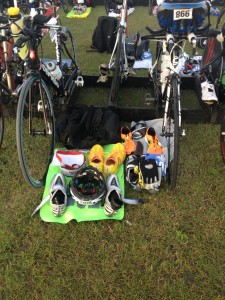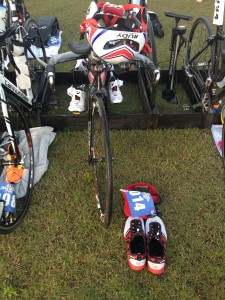Repeat after me: The objective to any multisport race is to get from the start line to the finish line in the least amount of time possible.
Now that we have that out of the way, we can proceed.
If there is one thing we as coaches know about mutlisport athletes, it is that they love to swim, bike, and run! And for most … that’s about it.
For some it’s a time issue. Adding in other training sessions just doesn’t fit [conveniently] in their available training time. For others, it’s because they think that doing anything more will make them faster (see definition of insanity).
The vast majority of endurance athletes tend to miss one very important part to the puzzle (we can think of more, like strength work, but let’s just say one so you don’t think we are being dramatic):
Enter…Sport Specific Skills
Sport specific skills cover everything from proper biomechanics to the lost art of lighting fast transitions.
Think about it –
- Racers will seek out the fastest wetsuit on the market to drop their swim time.
- Racers will drop [lots of] money on a helmet that will save them maybe 20 seconds over the entire bike leg.
- Racers will devote countless hours to dropping 5 seconds per mile off their 5k time.
- Many racers will then lose all those valuable seconds with poorly thought out, poorly executed, inefficient transitions.
It’s not uncommon to see long course athletes losing minutes to unorganized transition bags or folks running aimlessly up and down transition racks looking for their bike. Or the athlete who wastes wayyy too much time in transition sifting through piles of unnecessary items. We are not kidding when we say you can gain or lose precious seconds, even minutes in T1 and T2.
With all those valuable seconds on the line: this is an aspect of the sport you MUST practice. It is no less important than swimming, biking, or running.
We know a smoking fast T1 is not what everyone is looking at on the results sheet. Unless of course there was an award for that.
Hmmm…there’s a thought….maybe we can lobby race directors to start giving out some “Fastest T1 and T2” awards.
Alright, now that we’ve established the reason why you should be focusing on your transitions, here are our Top Transition Tips (so you can slip in and out of transition before anyone knows you’re there):
1. Declutter – This is seriously the top tip right off the bat. Anything you are not using for the race needs to be out of transition before you start. Put the pumps, buckets, and bags back in your car before the race starts. Check out the pictures below and their perspective T1 and T2 times. The picture on the left is actually 2 different athletes’ areas smashed into one spot. All 3 bikes were in a row in a large grass transition area. Had the athletes on the left had the same transitions as the athlete on the right, they would have moved up at least 5 spots in their age group. That’s not an exaggeration. I can check results just like you folks.


2. Organize – Make sure everything is organized in space so it is in the order of what you will do once you reach your spot for both T1 and T2. Bonus: Generally that means getting your shades/helmet on first in T1 and taking it off last in T2. Put all your nutrition (if any) on the bike, or start the race with your run nutrition on you. Lay your running shoes on your hat and number, not the other way around.
3. Mark Your Spot – Running to the wrong spot is a huge waste of time. I’ve done it several times in big races. The larger the transition area, the more difficult it is to find your spot, especially when you just got out of an MMA fight in the water. Some races will mark the lanes so you just have to remember the number or letter combo. In smaller races, some people use chalk to mark their row. In Ironman races, you can use colored tape or zip ties on your bags to make them stand out from the 2000 others you are surrounded by.
4. Learn the Flying Mount and Dismount – A lot of folks are intimidated by these speedy maneuvers, but they are absolutely the fastest way on and off the bike. Re-read the bold statement above and then think what your mount and dismount are doing to your overall time, before you even get into transition! And for all you cyclists that like to swim and/or run from time to time, that’s time added to you Strava segment, I mean, bike leg.
5. The Ole T2 Grab and GO! – There is no rule that says you have to have your hat, shades, and number on before you leave T2. Get your shoes on, helmet off, grab everything and get the heck out!
6. Bike Check One Two One Two – Before you head toward the start line, do one last check of your bike’s tires, air pressure, and shifting. Also make sure the bike is in the proper gear for your style mount and the start of the bike course. I almost always start in the small chain ring.
7. Practice, Practice, Practice – If the only time you run through a full speed transition is on race day, you are leaving time on the course. Pro athletes spend an average of 8-11 seconds at their spot in T1 and 6-8 seconds at their spot in T2 (not counting running in and out). They don’t get that fast by doing a couple half speed run throughs the night before. Know your set up, your equipment, your processes, and practice them over and over until its done with minimal thought. As a bonus, being confident in your transitions means one less thing to be nervous about on race day.
